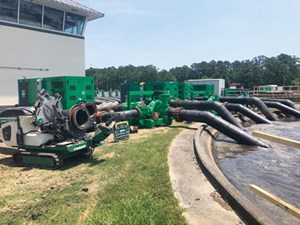January 2022 Vol. 77 No. 1
Rehab Technology
Innovative Solutions Address Challenges with Lower Berkeley WWTP Bypass
By Dwight Evans, Sunbelt Rentals
To ensure their success, bypass projects require stakeholders to devise detailed solutions, while also planning for the unexpected. Making improvements to the aging infrastructure at the Lower Berkeley Wastewater Treatment Plant (WWTP) was no exception.
Located outside of Charleston, S.C., the WWTP updates required a bypass between an aeration basin and four clarifiers to refurbish piping — above and underground — and to replace valves. Heron Construction of Wakefield, Mass., served as the contractor heading up the project, in partnership with Sunbelt Rentals as the equipment provider. Together, the two companies developed and implemented several solutions to address the challenges of the aeration system rehabilitation.
The challenges
The Lower Berkeley WWTP aeration basin that required improvements is approximately 300 feet long and 12 feet deep. It operates by way of a horizontal surface aerator system, featuring six sets of paddles. These paddles continuously turn the water counterclockwise to introduce air into the waste stream and allow biomass to stay alive.
The challenge of running a bypass from the aeration basin to the four clarifiers was two-fold. First, there was very limited space to implement the required number of diesel and electric pumps to handle backup flow. Second, the bypass required holding the water level in the aeration basin vertically within eight inches — similar bypass projects typically allow three to five feet of variance to control the water level. If the water lowered too far, the aeration paddles would no longer touch the water, preventing them from introducing air into the waste stream. Conversely, if the water rose too high, it would trip the breaker.
Solutions
Addressing these challenges required placing eight, 18-inch DR17 HDPE suction tubes into the aeration basin and mating them to eight 12-inch pumps. Each pump discharged utilizing 12-inch DR26 HDPE pipes connected to a discharge manifold that, in turn, tied into four parallel runs of 24-inch DR26 HDPE pipe. In addition, four 24-inch pipes connected between the clarifiers.
Because of the limited space to run these pipes between the aeration basin and the four clarifiers, they had to be placed much closer together than usual during a bypass. Sunbelt Rentals also had to figure out how to position the pumps. The solution consisted of four electric 150 HP, 12-inch pumps operating on the temporary site utility power that was available. These pumps handled the peak flow and the average daily flow during the bypass. Four diesel 150 HP, 12-inch pumps backed up the electric pumps for a power-out condition. Because of the limited space, project managers needed to alter the pump configuration, staggering the electric and diesel pumps.
Connecting high-resolution, submersible level transducers to variable frequency drives (VFD) controlled the pump operation according to flow, ensuring water levels remained within the allowable eight-inch depth. The four primary electric pumps operated to each manage two inches of water vertically. The four diesel pumps were each offset by one inch. This arrangement kept the amount of water coming in consistent with the amount being pumped out — staying within the eight-inch variance.
Backup
While the diesel pumps served as backup to the main electric pumps, the PumpSentri telemetry system from Sunbelt Rentals provided further protection. PumpSentri — integrated on both the electric driven and diesel driven pumps — offered remote monitoring and data logging throughout the bypass. This eliminated the need to employ a 24-hour, onsite pump watch, as well as the associated cost.
PumpSentri also allowed fault alarms to be selected according to stakeholders’ preference — text, email or voice call. Emergency project contacts receive alerts when standby pumps turn on or water levels are too high. It is added assurance to safeguard against critical conditions that could damage equipment or jeopardize a bypass project.
In the case of the Lower Berkeley WWTP project, PumpSentri alerted personnel of one potential event.
The system also allowed project managers to monitor pump activity around the clock, along with providing information on pump vacuum pressure, discharge pressure and vibration. Check-engine status and runtime were also accessible.
With innovative solutions to address both space limitations and tight water-level variance, improvements to the aeration system at the Lower Berkeley WWTP were a success. As with any bypass project, clear communication and a solid partnership between stakeholders also contributed to getting the job done well and on time. The project took two months to complete.
DWIGHT EVANS is the manager – technical support, Pump Solutions for Sunbelt Rentals
LEFT: Addressing the limited space and project requirement to evenly divide the flow from eight pumps into four aeration basins, stakeholders implemented a common manifold that hydraulically balanced the system flow.
ABOVE: The bypass required holding the water level in the aeration basin vertically within eight inches – similar bypass projects typically allow three to five feet of variance to control the water level.





Comments